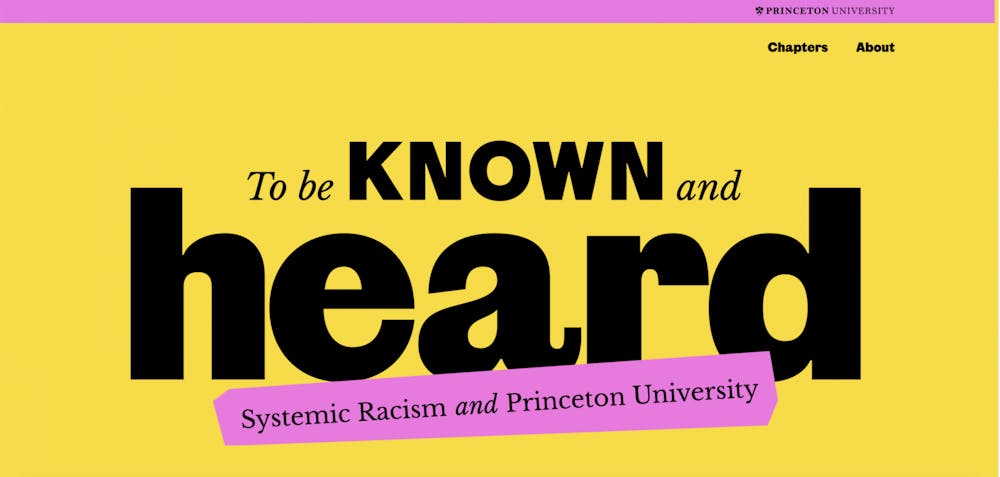The Class of 2025 was the first to engage with a new orientation training module designed to facilitate discussions of the University’s racist history and the power of student activism.
The module centered around the To Be Known and Heard virtual gallery, which depicts vignettes of “Princeton’s long and complex relationship with racism” starting from the 18th century to modern time, according to the site. During the training session, residential college advisers (RCAs) led their first-years through explorations of the virtual gallery and discussions on how to navigate conversations around race and identity.
In companionship with the gallery, RCAs and their first-year mentees viewed a pre-recorded roundtable discussion between four Princeton faculty members, highlighting certain events found within the gallery.
RCA for Butler College Patrice McGivney ’23 mentioned how the first-years in their group maintained an atmosphere of respect that allowed for honest conversations.
“Several of my ’zees shared ... that Princeton was the most diverse place they’ve ever been ... They were glad for the video, they felt like they needed to learn more about how to be respectful of different identities,” McGivney said.
Some of the faculty in the video spoke about the crucial work of student activists in making the University a more inclusive and introspective place over the years.
Associate Professor of History Beth Lew-Williams mentioned the 1995 sit-in at Nassau Hall organized by 17 student activists to protest the lack of diversity in the University’s curriculum and to advocate for hiring faculty for Asian-American and Latino Studies.
In the round-table discussion, Associate Professor of Classics Dan-el Padilla Peralta also talked about the future of alliances between activists of different backgrounds.

“As the University, under pressure from student activism, really begins to reimagine its purpose and obligation beyond the FitzRandolph Gate, the possibilities for coalition building will only multiply,” he said.
“My hope is that first-years took away from the video the importance of the archival and investigative work required to assemble the virtual gallery’s institutional history, and the urgency of supporting and building on that work instead of running away from its findings,” Peralta wrote in a statement to The Daily Princetonian.
Likewise, Lew-Williams wrote to the ‘Prince,’ “When students arrive at Princeton, they enter a community, institution, and space that was produced, in part, by past racial beliefs and systems of power. It’s better to understand this legacy we’re living within than try to ignore it.”
The theme of student activism resonated with many first-years and RCAs. Sydnae Taylor ’23, an RCA in Butler College, talked to the ‘Prince’ about feeling empowered by the virtual gallery.

“I personally didn’t know how important Princeton students were in activism spaces here, and how their work was so essential in terms of changing and creating all the spaces that we have today,” Taylor said. “It showed me, and all the people who engaged with the program, how as students, our voices matter.”
The virtual gallery itself came about as a result of Princeton students’ activism.
“[The gallery was] a response to Princeton students who frequently reach out to Campus Life offices because they want to learn more about Princeton’s history of race, racism, and anti-racism,” wrote Director for Wintersession and Campus Engagement (OWCE) Judy Jarvis and Assistant Dean of Diversity and Inclusion and Director, The Carl A. Fields Center for Equality and Cultural Understanding (CAF) Tennille Haynes in a joint statement to The Daily Princetonian.
The gallery was created by the OWCE and CAF.
“Our gallery does not represent an official institutional view or perspective, nor is it a complete recounting of Princeton’s history,” wrote Jarvis and Haynes. “Instead, it uses race as the organizing principle and lens to understand our present, recent past, and present moments.”
Two University professors recently penned an op-ed in the New York Post criticizing the orientation event, referring to it as a “one-sided and negative picture of Princeton’s history.”
Other community members felt that the gallery was limited in informing students about systemic racism.
McGivney pointed out that in its focus on historical wrongdoings, the presentation failed to give incoming students a picture of the current struggles of inequality within the University.
“It’s much easier to admit to past mistakes than to ongoing stuff,” they said.
Taylor also mentioned that the tone of the gallery, in attempting to present nuanced depictions of racist men, fell short of directly condemning their actions.
“I’d like to see [the gallery] call it out as clearly wrong, no ifs, ands, or buts,” she said.
Asked about the potential role of To Be Known and Heard in future orientations, Jarvis and Haynes wrote that nothing has been decided yet.
”Each year, the orientation organizers and their campus partners determine the diversity, equity and inclusion sessions, so we will return to that conversation in the spring of 2022 to figure it out with orientation leaders.”
They stressed the importance of students’ perspectives, stating, “We will particularly take into account student feedback (especially first-year students and RCAs) to determine what’s next for To Be Known and Heard.”
Editor’s Note: This article has been updated to correct Haynes’ title.
Ngan Chiem is a junior in the Politics Department pursuing a Certificate in Creative Writing. In her free time, if she's not cooking Viet food, Ngan enjoys covering student activism on campus. She can be reached at nchiem@princeton.edu and on Instagram @nganstop.








